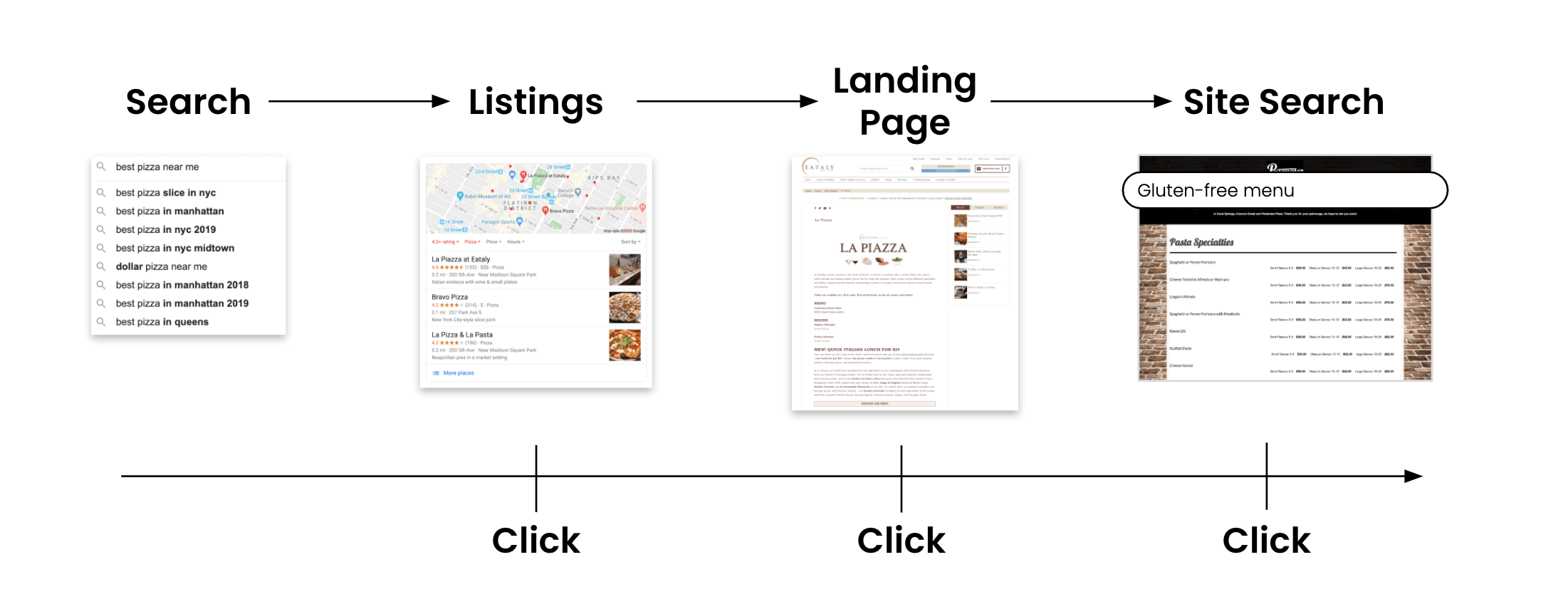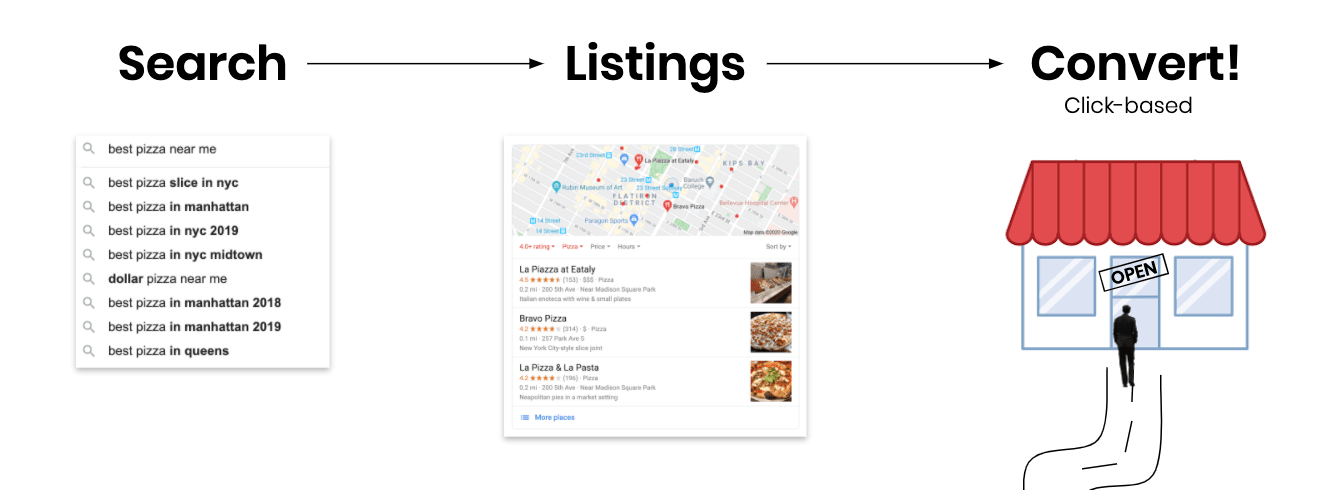Why Clicks Measure Success in Search | Yext Hitchhikers Platform
What You’ll Learn
In this section, you will learn:
- How to measure success in search
- When and where clicks can factor into a customer journey
- How to use clicks to optimize your search strategy
Why Clicks Measure Success in Search
Think back to the last time you searched for something or made a purchase online — you probably started by asking a question on a site like Google or by going directly to the brand’s website. Regardless of your experience, your journey was likely filled with questions and clicks until you found the information (or action) that you’re looking for.
To illustrate the different ways consumers can engage with brands today, here’s an example of someone trying to order pizza:

This consumer started by searching for ‘pizza near me’ on Google, then selected one of the answers Google provided (click). Wanting to learn more about what kind of pizza the restaurant offers, they went to the website to look up their menu (click). But someone in their party is gluten-intolerant, so they asked what menu items available were gluten-free (click). These types of clicks are happening across all of your digital properties. Measuring how many clicks you are generating will help you better understand how consumers are finding and engaging with your brand.
Some businesses might value some clicks more than others. In the pizza example above, clicking for ‘driving directions’ (because it leads to an in-store purchase), or clicking a ‘place an order’ button on their site brings real revenue to their business. As a result, those actions are highly valuable to this pizza restaurant and they would categorize them as conversions.
Clicks to Conversions
Conversions can occur with any listing, landing page, or site search experience — and conversions can be anything! Clicks for Driving Directions, Place an Order, Book an Appointment, Newsletter Signup, Rewards Membership — whatever brings value to your business (learn more in the Conversion Tracking Best Practices Unit ). Here are some examples to walk through what a conversion might look like across listings, landing pages, and site search experiences:
In the first example below, a consumer can convert without ever navigating to the business’ website. They found what they were looking for and “converted” by clicking for ‘driving directions.’ The actual conversion here happens offline, but the click for directions is a very strong indicator that the customer will actually go to the restaurant and so we can place an expected value (i.e. conversion value) on that click.

In the next example, it might take that consumer a little bit longer to convert. After discovering your listing, they wanted to know if you had any specials or limited-time offers. Upon learning there was a 2-for-1 special, they “converted” by ‘placing an order’ from the site. In the Conversion Tracking Module , you’ll learn more about how you can leverage Yext Conversion Tracking to use tags to attribute these conversions to your Listings and Pages, or simply assign a conversion value to a specific CTA click on those Listings or Pages.

And lastly, after interacting with listings and landing pages, this consumer still wanted more information before making a purchase. They asked a direct question on the website to see if there were gluten-free menu items available. After learning that gluten-free pizza was available, they decided to place an order for ‘delivery’ directly on the site. Once again, it’s key to track this via tags or based on an assigned conversion value.

As you can see, consumers today have more ways than ever to discover, engage, and ultimately convert online. Tracking not only how many clicks you are generating, but also how valuable those clicks are, and how many of those clicks are turning into customers will allow you to holistically measure your brand’s success in search.
Optimization Over Time
Once you’re able to see where and how consumers are engaging with your brand, you can then use those insights to make strategic business decisions. For example, you can use this information to determine which parts of your business to allocate more paid-ad spending or which products/services should have their own landing pages. Some businesses want to allocate more budget for areas that aren’t performing well organically in search, while others choose to capitalize even more on areas that are with more paid spending.
Understanding how consumers engage with your brand will help you quickly determine which tactics or initiatives drive the most clicks. This information is extremely valuable because it allows you to replicate these successes across other areas of your business. For example, if your locations that receive more clicks (or more valuable clicks) are active social posting locations, then you can encourage all of your locations to post at least once a week.
When testing new products, services, or limited-time offers across a portion of your business — brands can easily analyze if those new offerings are contributing to success and decide if they want to implement those changes in other areas of their business. Analytics provide the data and insights to consistently make improvements that drive more clicks and conversions for your business.
Which of the following should NOT be considered a conversion?
True or False: A consumer can convert on Google.
Which of the following are properties a consumer can convert on? (Select all that apply)
Soon you'll be your brand's hero! 🎓

